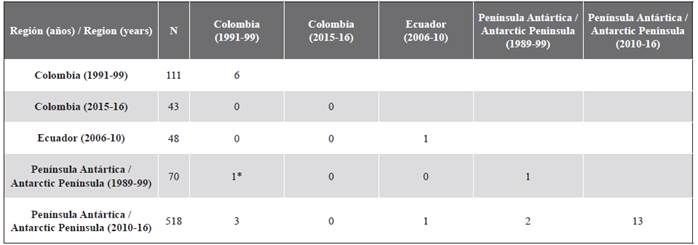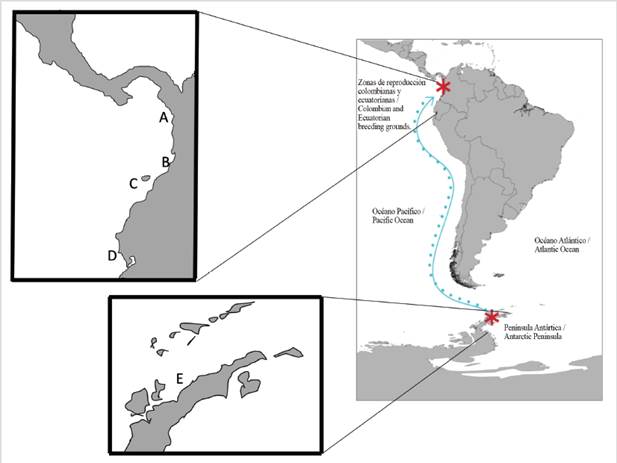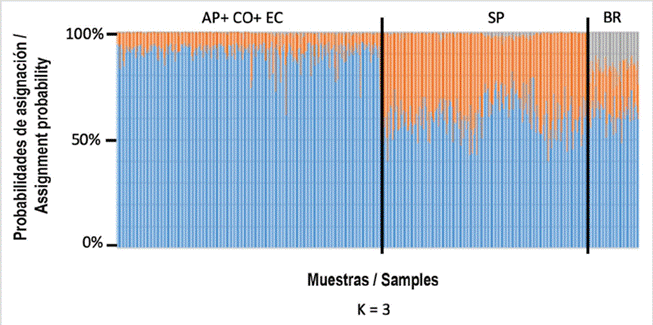INTRODUCTION
Humpback whales have a cosmopolitan distribution with populations in all three major ocean basins: North Atlantic, North Pacific and Southern Hemisphere. In the Southern Hemisphere, six breeding stocks are recognised by the IWC (IWC, 1998). The identity of each of these stocks has been defined because of their distribution in high latitude feeding grounds and breeding grounds in tropical sites. The migratory connections between summer and winter grounds have been suggested for these stocks based on photo ID comparisons (e.g., Flórez-González et al., 1998; Garrigue et al., 2002; Stevick et al., 2004; Acevedo et al. 2017) and mitochondrial DNA analyses (e.g., Baker et al., 1998; Olavarría et al., 2007; Félix et al., 2012) and recently, by genotype matching (Steel et al., 2017).
A migratory connection between breeding sites off the Pacific Coast of Colombia and the feeding grounds off the Antarctic Peninsula (Breeding Stock G) was described based on genetic analyses (Caballero et al., 2000, 2001; Olavarría et al., 2007). Among Southern Hemisphere stocks, the population that overwinters, and breeds, in the Colombian Pacific is significantly differentiated genetically from other populations in the region (Olavarría et al., 2007). Relatively high haplotype (h) and nucleotide (π) diversities have been reported for humpbacks in this breeding ground (Caballero et al., 2001; Olavarría et al., 2007). The Colombian breeding ground may be of particular importance as it has been suggested as a possible corridor for past or present genetic exchange between North Pacific and Southern Hemisphere humpbacks. This has been suggested due to the identification of shared control region haplotypes found between the Colombian breeding ground and breeding and feeding areas in the North Pacific (Caballero et al., 2001; Baker and Medrano-González, 2002)
Other areas in the southeastern Pacific have also been recognized as breeding grounds for stock G. These include the coast of Ecuador and the Galapagos Islands in the south, and the border between Panama and Colombia in the north (Félix et al., 2011, 2012). There appears to be some population stratification among locations constituting this breeding ground, since some haplotypes found in Ecuador have only been previously described in the Magellan Strait and not in the Antarctic Peninsula (Félix et al., 2012). Further molecular studies in these regions will allow for clarification of possible population stratification or fine-scale population structure among location in this breeding ground (Félix et al., 2012). Stratification of the BSG at breeding grounds has also been found using photo-identification (Acevedo et al., 2017) and satellite tagging (Guzmán and Félix, 2017).
Here we present results from genotype matching for samples from different locations among the southeastern Pacific breeding ground, including Coastal Ecuador, the Colombian Pacific Coast, and the Antarctic Peninsula.
STUDY AREA
Skin samples were collected from humpback whales during field seasons around Salinas, Ecuador between 2006 and 2010 (N=55), close to Nuquí, Tribuga Gulf, in the Northern Colombian Pacific in 2015 and 2016 (N=43), in Bahía Málaga and Gorgona Island, in the Southern Colombian Pacific (N=2), and in the Gerlach Strait, Antarctic Peninsula, as part of the first Colombian Antarctic Expedition in 2014 (N=14) (Table 1 and Figure 1).
Table 1 Summary of samples and DNA profiles from breeding grounds and Antarctic feeding grounds of stock G, including sex of the samples. QC refers to samples that passed the quality control parameters and were included in the analysis.

MATERIALS AND METHODS
Skin biopsies were collected using the Paxarms modified rifle (Krützen et al., 2002) and sloughed skin was collected from the water scooping it with a net (see Félix et al., 2012). Samples were preserved in ethanol 95 % and stored at 4º C before laboratory analysis. DNA was extracted following a skin tissue digestion with proteinase K and a standard phenol-chlorophorm extraction method (Sambrook et al., 1989). Genotyping of 15 microsatellite loci followed protocols from (Constantine et al., 2012) and (Steel et al., 2017) using previously published primers: Ev1, Ev14, Ev21, Ev37, Ev94, Ev96, Ev104 (Valsecchi and Amos, 1996) GATA417, GATA28 (Palsboll et al., 1997) rw31, rw 4-10, rw48 (Waldick et al., 1999) and GT211, GT575, GT23 (Bérubé et al., 2000). Individual identification was also confirmed by molecular sex identification and sequencing of the mitochondrial control region (mtDNA) following the protocols from (Olavarría et al., 2007). Microsatellite loci were amplified individually and PCR products were multiplexed for loading in an ABI 3730 xl DNA sequencer (Applied Biosystems), using 500LIZ™ size standard. Allele calling was done using ABI PRISM GeneMapper Software 4.0 (Life Technologies). Samples which amplified at less than 10 loci where considered poor quality and were removed from the dataset. Quality genotypes were resolved using the program CERVUS (Marshall et al., 1998) requiring the exact match of at least eight loci, supported by information on sex and mtDNA control region haplotype. Probability of identity (PI) values ranged between 2.1 x10-7 and 5.7 x10-12 for the minimum criterion of eight matching loci. Genotype comparisons were done using a DNA ‘register’ (i.e., a searchable electronic database of DNA profiles) of previously genotyped individuals from the Colombian breeding ground (N = 111; 1991-1999) and the Antarctic Peninsula feeding Area (N = 70; 1989-1999) both held by the South Pacific Whale Research Consortium (Steel et al., 2017) and, through a collaborative agreement, to a more recent collection from Antarctic Peninsula of 508 individuals (2010-2016; Pallin, 2018). Additionally, in order to confirm previously described patterns of genetic structure for the Eastern Pacific humpback whale stock, these were evaluated using STRUCTURE® v. 2.3 (Pritchard et al., 2000) which assigns individuals to groups using a Bayesian model-based method that minimizes linkage disequilibrium and deviations from Hardy-Weinberg expectations. The admixture model with correlated allele frequencies was selected to estimate the most likely number of gene pools (K) in the sample (length burn-in period: 10 000; MCMC: 100 000). This software also evaluates different K values using population ancestry models. Ten replicates where run in STRUCTURE and results were visualized in Structure Harvester (Earl and vonHoldt, 2012). For this analysis, 254 samples from Antarctic Peninsula, Colombia and Ecuador were used for comparisons with a subset of samples from Brazil (n=50) (Cypriano-Sousa et al., 2016) and from the South Pacific (New Caledonia, n = 50; French Polynesia and American Samoa, n = 100; Tonga, n= 50) (Steel et al., 2017)
RESULTS
One hundred and fourteen samples were obtained from skin biopsies or sloughed skin from three locations in the southeastern Pacific and the Antarctic Peninsula. We attempted to provide comparable DNA profiles of these samples for comparison to those held in the DNA register of the South Pacific Whale Research Consortium, including 16 microsatellite loci, mtDNA haplotypes and sex identification (Steel et al., 2017). All samples provided sex and mtDNA, information that helped in confirming potential recaptures (Table 1). Of the 15 microsatellite loci tried, one (EV21) failed to amplify and was dropped from further analyses. Four samples, all from Ecuador, failed to amplify for the minimum quality control (QC) criteria of 10 loci and were removed from the dataset.
Comparison of the remaining 110 genotypes revealed nine internal region matches, three within Ecuador, two within Colombia and four within the Antarctic Peninsula dataset (Table 1). All recaptures were within a field season with the exception of one individual, which was sampled in Ecuador in 2009 and again in 2010. After within-region replicates were removed the 101 individual genotypes were compared to 181 individuals sampled in Colombia (N = 111) and the Antarctic Peninsula (N = 70) almost 20 years earlier and to a large contemporary genetic catalogue from the Antarctic Peninsula (Pallin et al., 2017, N = 510; 2010 - 2016) (Table 2). Given the spatial and temporal overlap between the 10 individuals sampled in the Antarctic Peninsula as part of this study and the Pallin et al. (2018) genetic catalogue, these two datasets were compared first and then merged for later comparisons to the other temporal and spatial collections. Two recaptures were identified between the two datasets; one individual sampled in 2013 and again in 2015 and one sampled in 2015 and again in 2016. After removing these recaptures, a total of 518 individuals remained in the contemporary collection of DNA profiles from Antarctic Peninsula. Comparing genotypes of these individuals to genotypes of 70 individuals collected in the same region two decades earlier revealed two recaptures each spanning 18 years, one female sampled in 1996 and again in 2014 and another female sampled in 1997 and again in 2015 (Table 3). In contrast, no recaptures were found when comparing the recent breeding ground genetic catalogues (Colombia 2015-2017 and Ecuador 2006-2010) to the previous breeding ground genetic catalogue (Colombia 1991-1999) (Table 3). A comparison of genotypes between the three breeding grounds and the two feeding grounds revealed five recaptures (Table 3), one previously described in Steel et al. (2017), three between the Colombia 1991-1999 catalogue and the Antarctic Peninsula 2010-2016 collection and one between the Ecuador and the Antarctic Peninsula 2010-2016 collection (Table 3).
Table 3 Genotype recaptures within and between regional collections. Number on diagonal is between-year, within-region recaptures. Numbers below diagonal are between-region matches. * previously described recapture.

The analysis of genetic structure confirmed that all the samples belonged to one population (K=3) (Figure 2), confirming connectivity between Antarctic Peninsula feeding and breeding grounds, showing differentiation with groups from other areas of the Southern Hemisphere (South Pacific and Brazil) as previously established by other authors (Cypriano-Sousa et al., 2016; Steel et al., 2017).
DISCUSSION
Here we present results from genotype matching for samples from different locations among the Eastern Pacific breeding grounds and the feeding areas around Antarctic Peninsula for stock G. This is the first study presenting results for this stock from nuclear molecular markers, such as microsatellite loci, since all previous studies on this population had focused on mitochondrial DNA control region (Caballero et al., 2001; Olavarría et al., 2007). These results confirm previous knowledge regarding known genetic connectivity between feeding areas around the Gerlach Strait in Antarctic Peninsula and breeding areas of Colombia and Ecuador.
In this study we present individual genetic recaptures found between these two areas. Most of the recaptures found in our analyses were internal matches, but there were a few interesting recaptures in the same region for different years, both in breeding and feeding grounds, further supporting the findings by Steel et al. (2017).
Also, finding recaptures between breeding grounds and feeding grounds with samples collected 20 years apart provides indirect initial information about longevity of these individuals and confirms philopatry and a strong migratory connection between these areas for stock G. Also, the fact that no recaptures were found among samples collected in different areas within this breeding ground (Ecuador and the northern Colombian Pacific vs southern Colombian Pacific), temporally separated by 20 years, could support the hypothesis of population stratification within areas of this breeding ground (Félix et al., 2012; Guzmán and Félix, 2016). Future studies should include additional samples from these areas, plus samples from animals known to feed in the Magellan Strait and potentially breed in Panamá and Costa Rica (Acevedo et al., 2017).
Additional analyses will allow identification of other potential recaptures when this data are compared with the DNA register for the South Pacific and adjacent stocks (e.g., Brazil, Cypriano-Souza et al., 2016) and inform of potential cross hemisphere migration or genetic exchange when comparisons are done with samples from the North Pacific.











 text in
text in 






